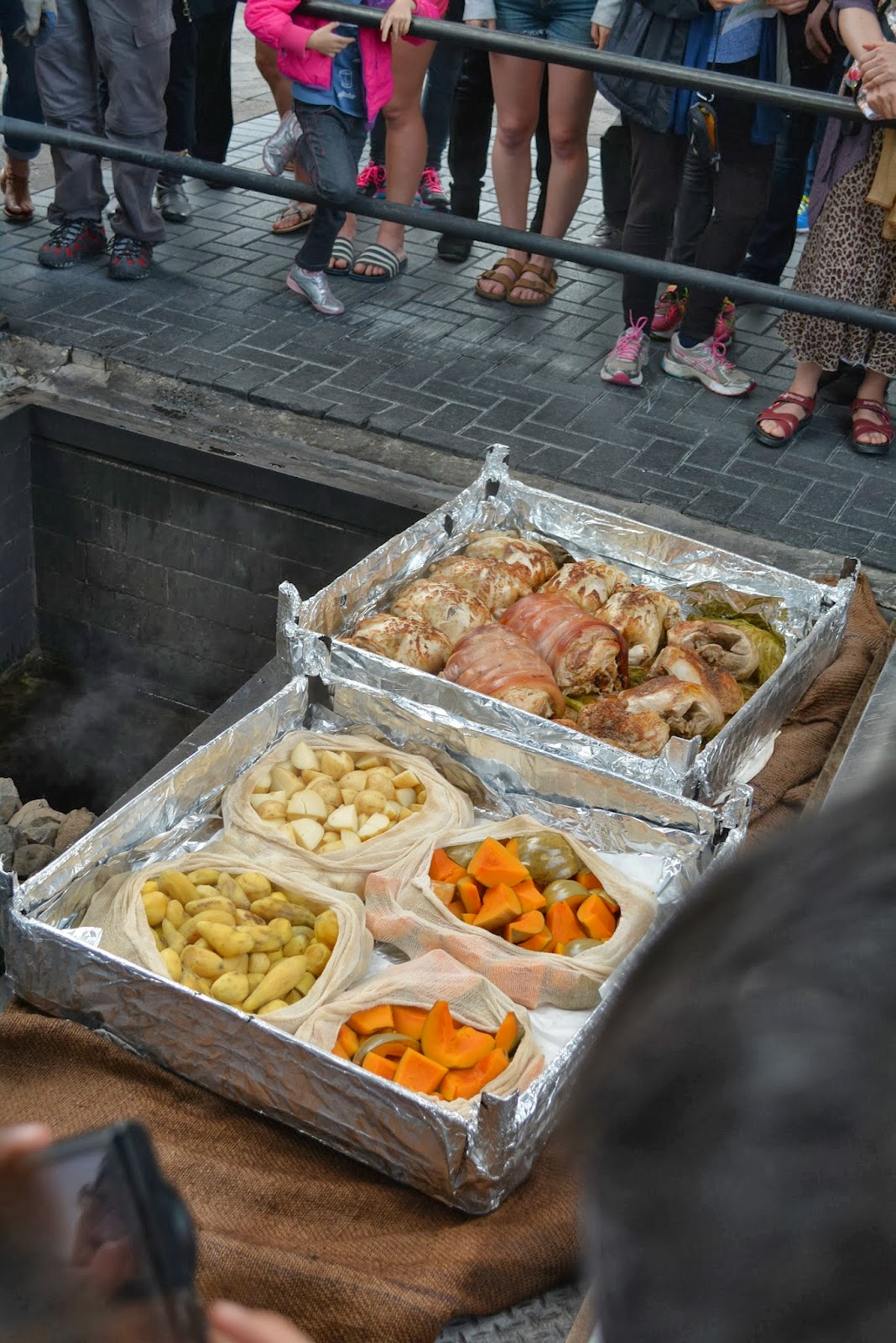Our morning started more slowly than most as many of our
students were out enjoying the international New Year’s Eve celebration. Today’s activities were relatively simple:
drive to Rotorua and enjoy an evening of Maori culture, including a traditional
dinner. We traveled from Auckland and
its background of volcanic silhouettes to one of the few sites on Earth where
geysers occur (Yellowstone National Park and Iceland are the other regions). Our arrival in Rotorua was greeted with
tell-tale sign of geysers: the smell of sulphur oxide (the potent odor of
rotten eggs!). The students deposited
their bags into the YHA (Youth Hostel Association) and were off to explore the
small, but tourist-friendly, town of Rotorua.
A few students found the choice (Kiwi for ‘excellent) pub that has Irish
plates for lunch specials, then all were ready on time (as always, it seems)
for our evening at Te Puia. Te Puia is a
family-run Maori experience that includes guided tours of the geysers around
the facility, background on the Maori tribe (iwi) living in the area through time, some of the cultural
practices of the Maori, including weaving and wood-carving, traditional song
and dance of the Maori, and a meal cooked in the Earth (a hangi). Our first experience
at Te Puia began with our guide, Carl, pulling our group aside from a large
group of tourists, and leading us on an entertaining tour of the facility.
Carl was quite the tour guide: he sprinkled humor among the
Maori stories, answered questions our group had on Maori traditions or the
natural phenomena all around us, and perhaps extended the truth of some stories
(for effect, clearly). Everyone got a kick out of Carl and
he was terrific to have as our guide for the afternoon. One of the fascinating things we learned
about the delicate nature of the ground surrounding the geysers. As the hot water/vapor/gases escape the
ground, the minerals from the water drop around the geyser as the water
evaporates in the air. The minerals then
form deposits that appear thick and solid, but they are anything but! The crusts formed by the minerals can easily
crack and break, and the subsequent holes can be large enough to swallow
whatever caused the break in the first place.
In the past, Moa, large flightless birds that weighed up to 1000 lbs
sometimes broke through the crust and died after either failing into the hole
and the boiling water below or died after failing to get out of what could be a
relatively deep hole. Furthermore, the
Haast Eagle, an extinct raptor that lived in New Zealand prior to humans
arrival, would sometimes attempt to retrieve a sunken Moa and end up getting
stuck in the hole as well. Oops!
Following our tour, we had the opportunity to witness a
traditional welcoming of strangers into the home of a Maori tribe. The host family sent a warrior out to make an
offering of peace to a representative of our group (we tried to convince Sean
Harrison of our group to do the honors to no avail). Upon our ‘chief’s’ acceptance of the peace
offering, we then entered the home (a reception room lined with traditional
wood carvings) and were ‘officially’ welcomed by the tribe. After several songs, the audience had the
opportunity to learn a Maori dance performed by the women of the tribe or the
war dance, called the ‘haka.’ Kristen
Maddock (Biology/Pre-med, 2019) and Lara Guindi (Biology/Pre-med, 2016) learned
and performed the poi dance, which
involved the swinging of a white ball attached to a length of red twine. Out of the group, our women were the best at
the dance! Following the poi dance, our host family performed a haka, the war dance used to
simultaneously excite the performing tribe and terrify the witnesses! After a rousing performance, the family
welcomed all of our young men to the stage to learn the steps/body slaps/shouts
performed during the haka. I haven’t seen
the video yet, but I felt like our group was pretty threatening! Following our haka, we soon made our way
towards dinner…
The Maori traditionally cooked meals in the Earth and called
the meal a ‘hangi’. A hole would be dug,
then filled with hot coals, then the food, and then covered with a plant
material to prevent the soil from spoiling the food during the day-long cooking
process. After our evening of song and
dance, we watched as our hangi was removed from the ground. The food, potatoes, kumara (sweet potato),
lamb, and fish, and more, looked and smelled sumptuous! We made our way to our tables and then
enjoyed the fruits of the Maori family’s labor….my goodness…this meal will
undoubtedly be the best meal of the trip!
It would be misleading to say that our students and James Moran (Natural
Sciences) and I ate well tonight; we ate gluttonously! Of course, we’ll need that energy come the
next few days!
Our night ended with another trip around the
geysers and hot chocolate for our efforts.
What a tremendous experience!
Carl talks to our group about the silver fern, one of New Zealand's national symbols.
A Maori warrior blows on a ceremonial horn that welcomes us into his family's greeting house.
 |
| Kristen Maddock (Biology, 2019) and Lara Guindi (Biology/Pre-med, 2016) perform the poi dance. |
Kate O'Driscoll (Biology/ Pre-med, 2016) and Lara Guindi (Biology/ Pre-med, 2016) listen to Carl talk about the geysers at Te Puia.
Kate O'Driscoll (Biology/ Pre-med, 2016), Lara Guindi
(Biology/ Pre-med, 2016), Chris Lorch (Nursing, 2019), Jason Lorch (Biology/ Pre-med, 2016), Dorian Shann (Physical Therapy, 2016) , and Jack Capetola (Chemistry, 2016) in front of the major geyser at Te Puia, Pohutou.
Our traditionally-cooked Maori meal (hangi) just after it was removed from the ground!
Our group getting ready to enjoy an incredible Maori meal!













































